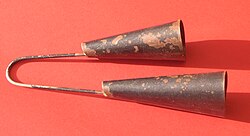Agogô
hideThis article has multiple issues. Please help or discuss these issues on the talk page. (Learn how and when to remove these template messages)
|
 Modern agogo bell | |
| Other names | gan gan (smaller version) |
|---|---|
| Hornbostel–Sachs classification | 111.242 (Bells) |
| Timbre | bright, uniform |
| Volume | medium to loud |
| Attack | fast |
| Decay | medium |
An agogô (Yoruba: agogo, meaning bell) is a single or a multiple bell now used throughout the world but with origins in traditional Yoruba and Edo music and also in the samba baterias (percussion ensembles). The agogô may be the oldest samba instrument and was based on West African Yoruba single or double bells. The agogô has the highest pitch of any of the bateria instruments.
Construction[]
Each bell is a different size. This allows a differently pitched note to be produced depending on which bell has been hit. Originally wrought iron, they are now manufactured in a variety of metals and sizes for different sound qualities. The most common arrangement is two bells attached by a U shaped piece of metal. The smaller bell is held uppermost. Either bell may be hit with a wooden stick to make a cowbell like sound or less commonly a clicking sound is produced by squeezing the two bells together.
Religious origins[]
It is used in the ceremonial music of religions in Yorubaland as well as in their new world practice, which is based on beliefs such as Candomblé brought by slaves from Africa.
Rhythmic patterns[]
Bell pattern 1 is the most basic, or archetypal pattern. It is the 4/4 form of what is known in ethnomusicology as the standard pattern, and known in Cuba as clave. Pattern 1 is used in maculelê and some Candomblé and Macumba rhythms. Bell 2 is used in afoxê and can be thought of as pattern 1 embellished with four additional strokes. Bell 3 is used in batucada. Pattern 4 is the maracatu bell and can be thought of as pattern 1 embellished with four additional strokes.
In rock music[]

- Copacabana, popular American disco song by Barry Manilow featuring an agogo bell solo in the introduction
- Love Rollercoaster, popular American funk song by Ohio Players featuring a prominent agogo bell
- Soulfly frontman Max Cavalera played a pair of agogô on the band's debut album.
- Cowbell
- Claves
References[]
External links[]
| Wikimedia Commons has media related to Agogô. |
| Look up agogo bell in Wiktionary, the free dictionary. |
- African percussion instruments
- Bells (instrument)
- Brazilian percussion
- Capoeira
- Central American and Caribbean percussion instruments
- Hand percussion
- Idiophones struck directly
- Latin percussion
- Metal percussion instruments
- Percussion instruments used in worship
- Samba
- South American percussion instruments
- Percussion instruments
- Unpitched percussion
- Yoruba musical instruments


